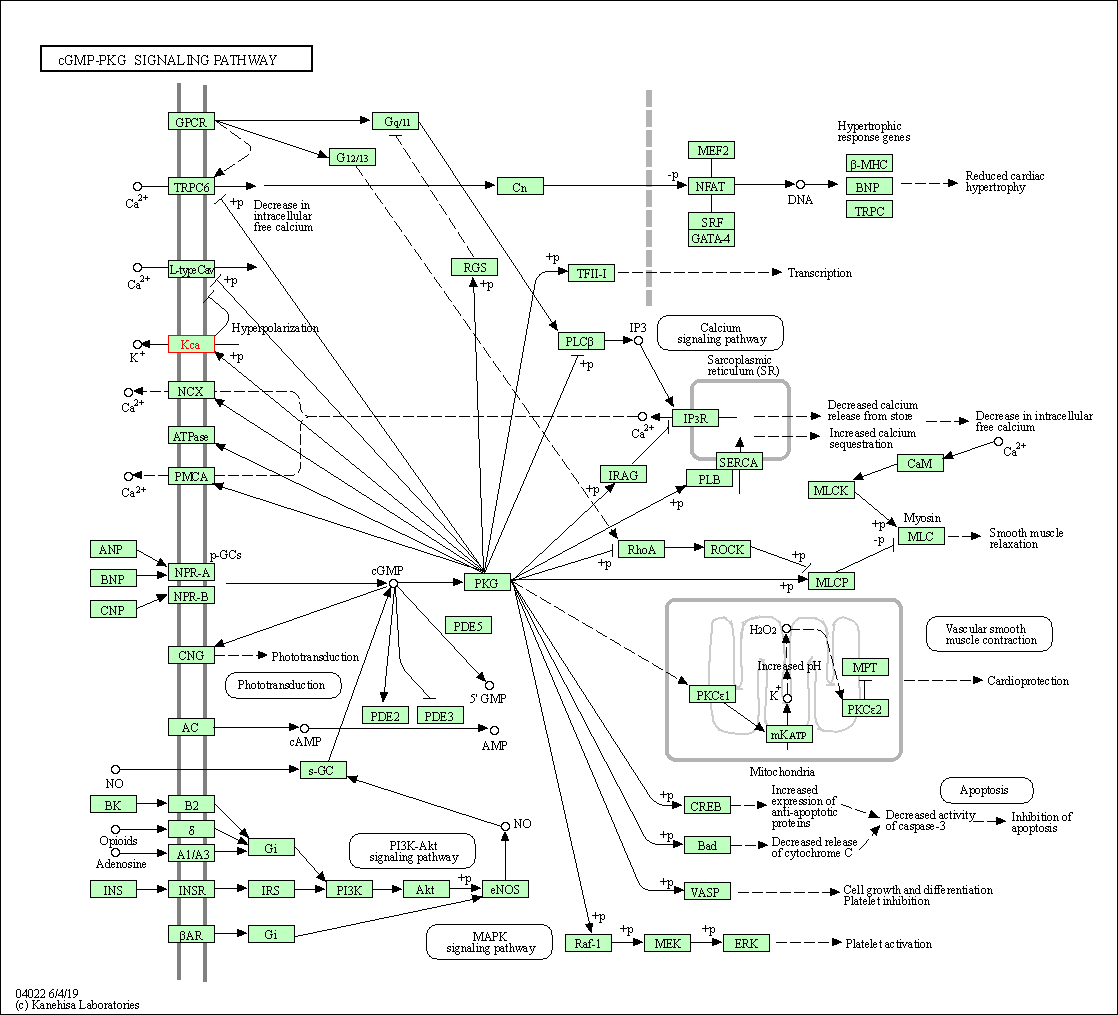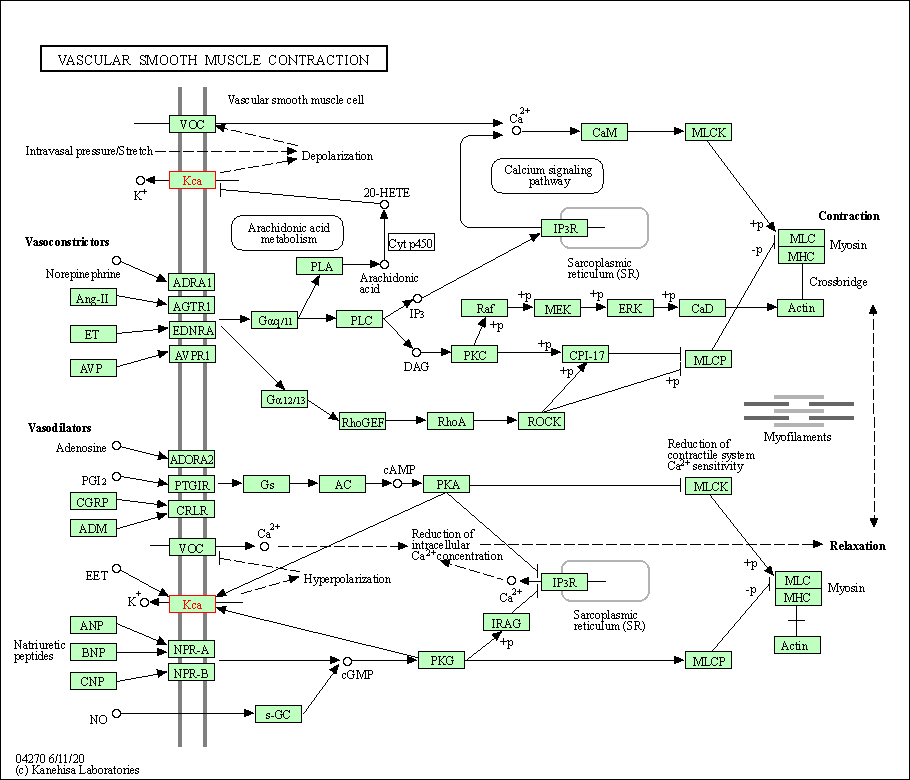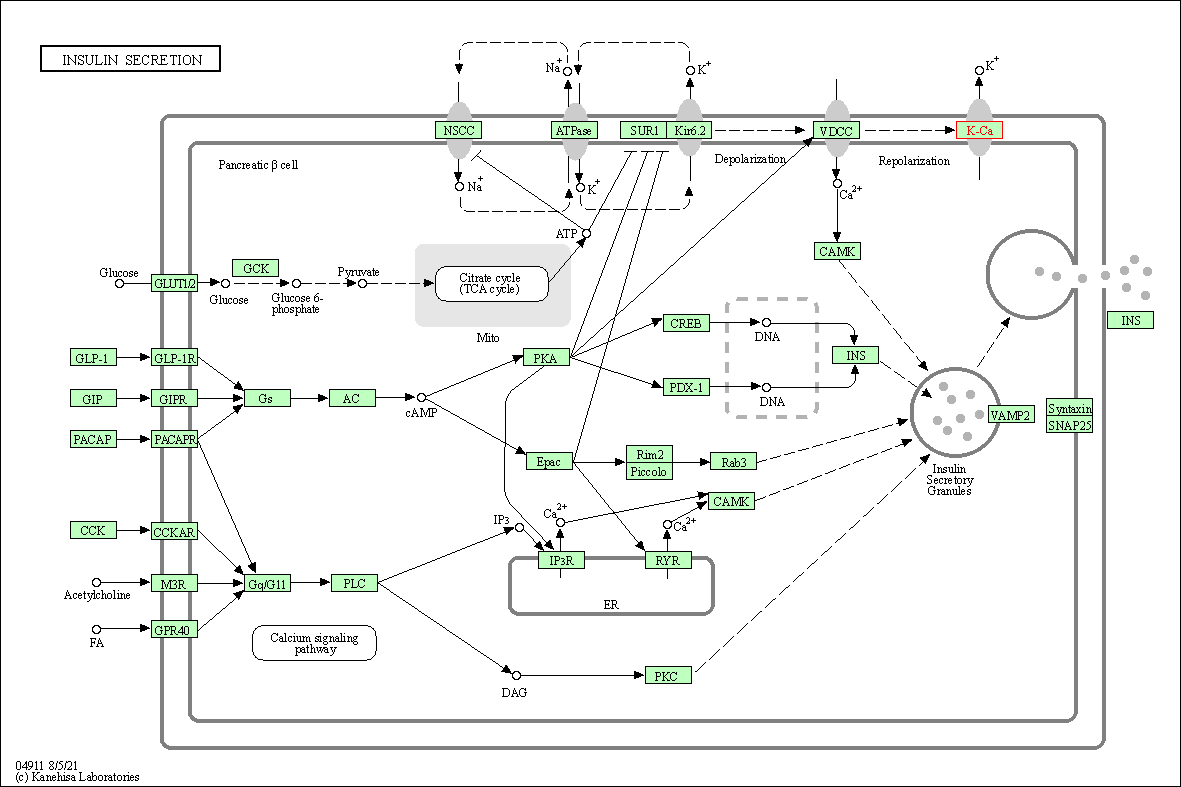Target Information
| Target General Information | Top | |||||
|---|---|---|---|---|---|---|
| Target ID |
T67063
(Former ID: TTDI01980)
|
|||||
| Target Name |
Charybdotoxin receptor beta-4 (BKbeta4)
|
|||||
| Synonyms |
KCNMB4; Calcium activated potassium KCNMA1 (maxiK) channel
Click to Show/Hide
|
|||||
| Gene Name |
KCNMB4
|
|||||
| Target Type |
Clinical trial target
|
[1] | ||||
| Disease | [+] 1 Target-related Diseases | + | ||||
| 1 | Sexual dysfunction [ICD-11: HA00-HA01] | |||||
| Function |
Regulatory subunit of the calcium activated potassium KCNMA1 (maxiK) channel. Modulates the calcium sensitivity and gating kinetics of KCNMA1, thereby contributing to KCNMA1 channel diversity. Increases the apparent Ca(2+)/voltage sensitivity of the KCNMA1 channel. It also modifies KCNMA1 channel kinetics and alters its pharmacological properties. It slows down the activation and the deactivation kinetics of the channel. Acts as a negative regulator of smooth muscle contraction by enhancing the calcium sensitivity to KCNMA1. Its presence is also a requirement for internal binding of the KCNMA1 channel opener dehydrosoyasaponin I (DHS-1) triterpene glycoside and for external binding of the agonist hormone 17-beta-estradiol (E2). Increases the binding activity of charybdotoxin (CTX) toxin to KCNMA1 peptide blocker by increasing the CTX association rate and decreasing the dissociation rate.
Click to Show/Hide
|
|||||
| UniProt ID | ||||||
| Sequence |
MAKLRVAYEYTEAEDKSIRLGLFLIISGVVSLFIFGFCWLSPALQDLQATEANCTVLSVQ
QIGEVFECTFTCGADCRGTSQYPCVQVYVNNSESNSRALLHSDEHQLLTNPKCSYIPPCK RENQKNLESVMNWQQYWKDEIGSQPFTCYFNQHQRPDDVLLHRTHDEIVLLHCFLWPLVT FVVGVLIVVLTICAKSLAVKAEAMKKRKFS Click to Show/Hide
|
|||||
| 3D Structure | Click to Show 3D Structure of This Target | PDB | ||||
| Drugs and Modes of Action | Top | |||||
|---|---|---|---|---|---|---|
| Clinical Trial Drug(s) | [+] 1 Clinical Trial Drugs | + | ||||
| 1 | BMS-223131 | Drug Info | Phase 2 | Erectile dysfunction | [1] | |
| Discontinued Drug(s) | [+] 2 Discontinued Drugs | + | ||||
| 1 | CNS-1237 | Drug Info | Terminated | Cerebrovascular ischaemia | [2] | |
| 2 | NS-1619 | Drug Info | Terminated | Asthma | [3], [4] | |
| Mode of Action | [+] 2 Modes of Action | + | ||||
| Modulator | [+] 3 Modulator drugs | + | ||||
| 1 | BMS-223131 | Drug Info | [1] | |||
| 2 | CNS-1237 | Drug Info | [5] | |||
| 3 | NS-1619 | Drug Info | [6] | |||
| Inhibitor | [+] 2 Inhibitor drugs | + | ||||
| 1 | iberiotoxin | Drug Info | [7] | |||
| 2 | [14C]TEA | Drug Info | [7] | |||
| Cell-based Target Expression Variations | Top | |||||
|---|---|---|---|---|---|---|
| Cell-based Target Expression Variations | ||||||
| Drug Binding Sites of Target | Top | |||||
|---|---|---|---|---|---|---|
| Ligand Name: Cholesterol | Ligand Info | |||||
| Structure Description | Cryo-EM structure of Ca2+-bound hsSlo1-beta4 channel complex | PDB:6V22 | ||||
| Method | Electron microscopy | Resolution | 3.20 Å | Mutation | No | [8] |
| PDB Sequence |
AYEYTEAEDK
2016 SIRLGLFLII2026 SGVVSLFIFG2036 FCWLSPALQD2046 LQATEANCTV2056 LSVQQIGEVF 2066 ECTFTCGADC2076 RGTSQYPCVQ2086 VYVNNSESNS2096 RALLHSDEHQ2106 LLTNPKCSYI 2116 PPCKRENQKN2126 LESVMNWQQY2136 WKDEIGSQPF2146 TCYFNQHQRP2156 DDVLLHRTHD 2166 EIVLLHCFLW2176 PLVTFVVGVL2186 IVVLTICAKS2196 LAVKAEAMK
|
|||||
|
|
||||||
| Click to View More Binding Site Information of This Target and Ligand Pair | ||||||
| Ligand Name: (1r)-2-{[(S)-{[(2s)-2,3-Dihydroxypropyl]oxy}(Hydroxy)phosphoryl]oxy}-1-[(Hexadecanoyloxy)methyl]ethyl (9z)-Octadec-9-Enoate | Ligand Info | |||||
| Structure Description | Cryo-EM structure of Ca2+-free hsSlo1-beta4 channel complex | PDB:6V35 | ||||
| Method | Electron microscopy | Resolution | 3.50 Å | Mutation | No | [8] |
| PDB Sequence |
YEYTEAEDKS
2017 IRLGLFLIIS2027 GVVSLFIFGF2037 CWLSPALQDL2047 QATEANCTVL2057 SVQQIGEVFE 2067 CTFTCGADCR2077 GTSQYPCVQV2087 YVNNSESNSR2097 ALLHSDEHQL2107 LTNPKCSYIP 2117 PCKRENQKNL2127 ESVMNWQQYW2137 KDEIGSQPFT2147 CYFNQHQRPD2157 DVLLHRTHDE 2167 IVLLHCFLWP2177 LVTFVVGVLI2187 VVLTICAKSL2197 AVKAEAMK
|
|||||
|
|
||||||
| Click to View More Binding Site Information of This Target with Different Ligands | ||||||
| Different Human System Profiles of Target | Top |
|---|---|
|
Human Similarity Proteins
of target is determined by comparing the sequence similarity of all human proteins with the target based on BLAST. The similarity proteins for a target are defined as the proteins with E-value < 0.005 and outside the protein families of the target.
A target that has fewer human similarity proteins outside its family is commonly regarded to possess a greater capacity to avoid undesired interactions and thus increase the possibility of finding successful drugs
(Brief Bioinform, 21: 649-662, 2020).
Human Pathway Affiliation
of target is determined by the life-essential pathways provided on KEGG database. The target-affiliated pathways were defined based on the following two criteria (a) the pathways of the studied target should be life-essential for both healthy individuals and patients, and (b) the studied target should occupy an upstream position in the pathways and therefore had the ability to regulate biological function.
Targets involved in a fewer pathways have greater likelihood to be successfully developed, while those associated with more human pathways increase the chance of undesirable interferences with other human processes
(Pharmacol Rev, 58: 259-279, 2006).
Biological Network Descriptors
of target is determined based on a human protein-protein interactions (PPI) network consisting of 9,309 proteins and 52,713 PPIs, which were with a high confidence score of ≥ 0.95 collected from STRING database.
The network properties of targets based on protein-protein interactions (PPIs) have been widely adopted for the assessment of target’s druggability. Proteins with high node degree tend to have a high impact on network function through multiple interactions, while proteins with high betweenness centrality are regarded to be central for communication in interaction networks and regulate the flow of signaling information
(Front Pharmacol, 9, 1245, 2018;
Curr Opin Struct Biol. 44:134-142, 2017).
Human Similarity Proteins
Human Pathway Affiliation
Biological Network Descriptors
|
|
|
There is no similarity protein (E value < 0.005) for this target
|
| KEGG Pathway | Pathway ID | Affiliated Target | Pathway Map |
|---|---|---|---|
| cGMP-PKG signaling pathway | hsa04022 | Affiliated Target |

|
| Class: Environmental Information Processing => Signal transduction | Pathway Hierarchy | ||
| Vascular smooth muscle contraction | hsa04270 | Affiliated Target |

|
| Class: Organismal Systems => Circulatory system | Pathway Hierarchy | ||
| Insulin secretion | hsa04911 | Affiliated Target |

|
| Class: Organismal Systems => Endocrine system | Pathway Hierarchy | ||
| Degree | 2 | Degree centrality | 2.15E-04 | Betweenness centrality | 1.01E-03 |
|---|---|---|---|---|---|
| Closeness centrality | 1.48E-01 | Radiality | 1.19E+01 | Clustering coefficient | 0.00E+00 |
| Neighborhood connectivity | 4.00E+00 | Topological coefficient | 5.00E-01 | Eccentricity | 14 |
| Download | Click to Download the Full PPI Network of This Target | ||||
| Drug Property Profile of Target | Top | |
|---|---|---|
| (1) Molecular Weight (mw) based Drug Clustering | (2) Octanol/Water Partition Coefficient (xlogp) based Drug Clustering | |
|
|
||
| (3) Hydrogen Bond Donor Count (hbonddonor) based Drug Clustering | (4) Hydrogen Bond Acceptor Count (hbondacc) based Drug Clustering | |
|
|
||
| (5) Rotatable Bond Count (rotbonds) based Drug Clustering | (6) Topological Polar Surface Area (polararea) based Drug Clustering | |
|
|
||
| "RO5" indicates the cutoff set by lipinski's rule of five; "D123AB" colored in GREEN denotes the no violation of any cutoff in lipinski's rule of five; "D123AB" colored in PURPLE refers to the violation of only one cutoff in lipinski's rule of five; "D123AB" colored in BLACK represents the violation of more than one cutoffs in lipinski's rule of five | ||
| Target Profiles in Patients | Top | |||||
|---|---|---|---|---|---|---|
| Target Expression Profile (TEP) | ||||||
| Target Affiliated Biological Pathways | Top | |||||
|---|---|---|---|---|---|---|
| KEGG Pathway | [+] 5 KEGG Pathways | + | ||||
| 1 | cGMP-PKG signaling pathway | |||||
| 2 | Vascular smooth muscle contraction | |||||
| 3 | Insulin secretion | |||||
| 4 | Salivary secretion | |||||
| 5 | Pancreatic secretion | |||||
| Reactome | [+] 1 Reactome Pathways | + | ||||
| 1 | cGMP effects | |||||
| WikiPathways | [+] 2 WikiPathways | + | ||||
| 1 | Potassium Channels | |||||
| 2 | Platelet homeostasis | |||||
| References | Top | |||||
|---|---|---|---|---|---|---|
| REF 1 | Effect of 4-(5-chloro-2-hydroxyphenyl)-3-(2-hydroxyethyl)-6-(trifluoromethyl)-quinolin-2(1H)-one (BMS-223131), a novel opener of large conductance ... J Pharmacol Exp Ther. 2005 May;313(2):840-7. | |||||
| REF 2 | Trusted, scientifically sound profiles of drug programs, clinical trials, safety reports, and company deals, written by scientists. Springer. 2015. Adis Insight (drug id 800001959) | |||||
| REF 3 | URL: http://www.guidetopharmacology.org Nucleic Acids Res. 2015 Oct 12. pii: gkv1037. The IUPHAR/BPS Guide to PHARMACOLOGY in 2016: towards curated quantitative interactions between 1300 protein targets and 6000 ligands. (Ligand id: 4272). | |||||
| REF 4 | Trusted, scientifically sound profiles of drug programs, clinical trials, safety reports, and company deals, written by scientists. Springer. 2015. Adis Insight (drug id 800001878) | |||||
| REF 5 | Effects of Ca2+ and Na+ channel inhibitors in vitro and in global cerebral ischaemia in vivo. Eur J Pharmacol. 1997 Aug 6;332(2):121-31. | |||||
| REF 6 | BK channel activation by NS-1619 is partially mediated by intracellular Ca2+ release in smooth muscle cells of porcine coronary artery | |||||
| REF 7 | URL: http://www.guidetopharmacology.org Nucleic Acids Res. 2015 Oct 12. pii: gkv1037. The IUPHAR/BPS Guide to PHARMACOLOGY in 2016: towards curated quantitative interactions between 1300 protein targets and 6000 ligands. (Target id: 380). | |||||
| REF 8 | Molecular structures of the human Slo1 K(+) channel in complex with beta4. Elife. 2019 Dec 9;8:e51409. | |||||
If You Find Any Error in Data or Bug in Web Service, Please Kindly Report It to Dr. Zhou and Dr. Zhang.

